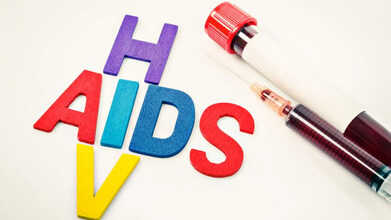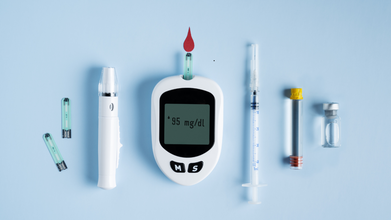- Health Conditions A-Z
- Health & Wellness
- Nutrition
- Fitness
- Health News
- Ayurveda
- Videos
- Medicine A-Z
- Parenting
RFK Jr. Opens Up About Heroin Addiction and Calls for Focus on Prevention

Credits: Instagram
During a recent conference on drug addiction, the US Health Secretary Robert F Kennedy Jr. shared a personal story about his own battle with drug addiction and his journey to recovery. He also emphasized on the importance of helping young people find meaning in life. His speech at the Rx and Illicit Drug Summit in Nashville, Tennessee, emphasized the need for prevention, community, and spiritual support in addressing substance abuse.
RFK Jr.'s Struggle With Addiction
Kennedy revealed that he was addicted to heroin for 14 years. It started during his teenage years. During that time, he constantly promised to quit to himself and his family, but he felt powerless to follow through.
“I didn’t want to be someone who woke up every morning thinking about drugs,” he said, describing the feeling of being unable to “keep contracts” with himself. He shared that he felt like he was born with a hole inside him—something many addicts feel—that he tried to fill with drugs.
He also called addiction "a source of misery, but also a symptom of misery". He stressed that threats of overdose or ruined lives often have little impact on those who are already suffering. “Every addict feels that way in one way or another... and the only thing that works are drugs,” he said.
His message to the 3,000 attendees focused on how deeper issues like hopelessness and disconnection from community contribute to addiction.
Finding A Way Out Through Faith
RFK Jr. went on to describe his recovery journey that started after he read a book by Swiss psychiatrist Carl Jung, who suggested that people who believe in God tend to recover more effectively. This inspired him and rekindled his faith in God. He began to attend the 12-step meetings. God was mentioned in his speech over 20 times, and it was noted that spirituality played a big role in his healing.
RFK Jr. also acknowledged criticism from public health experts and was interrupted several times by hecklers. Without directly engaging them, he said he tries to learn from everyone—“even the people who give me the finger.”
Prevention Through Purpose
While RFK Jr. did praise tools like Suboxone, methadone, and access to rehab, his main focus remained on prevention. “We have this whole generation of kids who’ve lost hope in their future,” he said. According to him, restoring connections to family, community, and purpose is crucial.
He encouraged policy changes that would promote stronger family bonds—such as phone-free meals—and more opportunities for young people to engage in service. “The best way to overcome hopelessness,” he said, “is to wake up each day and pray, ‘Please make me useful to another human being today.’”
While Kennedy’s speech resonated with many, others pushed back on his approach. Researcher Caleb Banta-Green, who was removed after shouting, later said that while spirituality can be helpful, science-based interventions must be prioritized and properly funded.
While Kennedy’s speech resonated with many, others pushed back on his approach. Researcher Caleb Banta-Green, who was removed after shouting, later said that while spirituality can be helpful, science-based interventions must be prioritized and properly funded.
World AIDS Day 2025: Experts Explain Which HIV “Facts” Are Actually Myths

Credits: Canva
World AIDS Day is marked across the globe every year on 1 December to draw attention to HIV and AIDS. In India, the day is observed through awareness drives and community-level programmes held nationwide. The National AIDS Control Organization (NACO), which functions under the Ministry of Health and Family Welfare, leads these efforts and brings people together to support the ongoing battle against the illness.
This year, the government reported a strong decline in HIV cases, noting 49 per cent fewer new infections since 2010, an 81 per cent fall in deaths linked to AIDS, and a 75 per cent drop in mother-to-child transmission between 2010 and 2024.
The update, shared on Sunday for World AIDS Day 2025, also underlines how myths continue to harm people living with HIV. Misconceptions remain widespread, including the belief that the virus spreads through simple physical contact.
What is HIV/AIDS?
The Human Immunodeficiency Virus (HIV) harms the body by attacking helper T-cells, which are vital for immunity. Acquired Immunodeficiency Syndrome (AIDS) develops when these cells fall to very low levels, leaving the body exposed to infections and diseases, as described by the Mayo Clinic.
Common HIV Myths That You Should Know About
There are many myths surrounding HIV/AIDS that people continue to believe, though experts have clarified the truth behind them: Dr Kajal Singh, Associate Professor, Obstetrics and Gynaecology Department, NIIMS Medical College and Hospital, Greater Noida, helped us debunk the myths.- It is a myth that HIV spreads through coughing, touching or shaking hands. Routine contact or a cough does not transmit the virus. Transmission can occur only when the skin has open sores or breaks that allow the virus to enter.
- It is a myth that a person diagnosed with HIV will survive only a short time. With proper treatment that keeps the virus suppressed, people with HIV can live for many years.
- It is a myth that every child born to an HIV-positive mother will also have HIV. With antiretroviral therapy, a planned C-section and other precautions, the chance of passing the virus to the baby can be reduced to below 2 per cent.
- It is a myth that HIV, being a viral infection, cannot be linked to the use of antibacterial or antifungal medicines. Since HIV weakens immunity, those living with it may be prone to common bacterial and fungal infections and may need such medicines for long periods.
- It is a myth that there is no risk when two or more HIV-positive partners are intimate. Unprotected sex can still allow tougher or drug-resistant strains of the virus to evolve and spread.
- It is a myth that people who do not show symptoms cannot have HIV. It can take years for signs to appear, and the only way to confirm the infection is through testing.
- It is a myth that taking medicines before intercourse can fully prevent HIV. Pre-exposure prophylaxis lowers the risk but does not remove it entirely.
World AIDS Day, observed each year on December 1, is a time to pause, acknowledge and renew our commitment. It pays respect to those who lost their lives to AIDS-related illnesses, offers support to people living with HIV and reminds the world that prevention, treatment and rights-based care remain essential. The theme for 2025, “Overcoming disruption, transforming the AIDS response”, urges countries to build stronger systems, widen access to services and uphold the dignity of all communities affected by HIV.
Who Was Ludwig Minelli, Founder of the Swiss Right-to-Die Organization, Who Died by Assisted Suicide at 92?

Credits: AP
Ludwig Minelli, 92, died on Saturday just days before his 93rd birthday, which would have been on December 5. He was the founder of Swiss right-to-die organization Dignitas. He has died by assisted suicide.
The members of organization paid tribute to him and said that he had always led a "life for freedom of choice, self-determination, and human rights".
Right-To-Die By Minelli
Minelli founded Dignitas in 1998, which has helped many people to choose how they wish to die with dignity. He however began his career as a journalist and worked as a correspondent for the German news magazine Der Spiegel. He then studied law and that is when his interest in human rights took off.
Throughout his life, he campaigned for the right to die and gave Dignitas the slogan: "dignity in life, dignity in death".
"I am persuaded that we have to struggle in order to implement the last human right in our societies. And the last human right is the right to make a decision on one's own end, and the possibility to have this end without risk and without pain," he said in a 2010 BBC interview.
He founded Dignitas after he split from an older Swiss assisted dying organization, Exit, because he said the rules felt too restrictive.
The reason for Dignitas to become famous was because the way it operated. Dignitas offered assisted suicide to non-Swiss citizens who travel to Switzerland because assisted dying is not permitted in their own countries. In a 2008 interview to Der Tagesspiegel, he said that Dignitas assisted 840 people to die, and 60% of them were Germans.
His Life Amid Criticism And Legal Battles
While he devoted his life for a cause, he was not spared from criticism. He was often criticized for an alleged lack of transparency over the financial dealings of the organization. He was further criticized for offering assisted dying options to those who were not terminally ill, but wanted to end their lives. He also faced numerous legal battles, and many of which were also appealed to Swiss apex court.
The Wins He Made
As per Dignitas, his work had a lasting influence. In 2011, the European Court of Human Rights announced the right of a person capable of judgment to decide on the manner and the time of their own end of life.
While in his own country, assisted dying was permitted under Swiss law since 1942, under strict condition, of course, Euthanasia still remains illegal there.
The main difference is that in Switzerland, a physician cannot administer a lethal injection, which is what euthanasia is. However, a physician can provide the means for a person to end their own life, and the individual must perform the final act themselves.
The legality of assisted suicide is based on Article 115 of the Swiss Criminal Code from 1942, which prohibits assistance only if motivated by selfish reason. The conditions for assisted suicide includes that the assistance must not be for selfish motives and must be provided to someone of sound mind who has made a self-determined and enduring decision to die. The person must also be suffering from an unbearable and uncontrollable condition.
Your Butt Shape Could Be a Clue to Your Diabetes Type; Here’s How

Credits: Canva
The shape of your gluteus maximus, the largest muscle in your backside, may offer surprising clues about your likelihood of developing diabetes. New research suggests that the contours of this major muscle change with age and health conditions, helping scientists better understand how fitness, muscle health, and metabolism are connected.
Ageing, Weight, and Diabetes: What We Already Know
For years, the NHS has warned that ageing and excess weight increase the risk of developing Type 2 diabetes. However, this new study goes beyond traditional measures, proposing that the shape of the gluteus maximus itself shifts as people age or develop conditions such as osteoporosis or diabetes. These subtle muscular changes could provide valuable information about a person’s metabolic health.
Why the Gluteus Maximus Matters
Researchers from the University of Westminster highlighted that the gluteus maximus plays a key role not just in movement but also in metabolic regulation. Healthy, well-maintained muscles can improve blood sugar control and reduce the burden on organs involved in glucose processing.
Dr Marjola Thanaj, co-author of the study from the university’s Research Centre for Optimal Health, explained, as reported by Independent: “People with higher fitness, as measured by vigorous physical activity and hand grip strength, had a greater gluteus maximus shape, while ageing, frailty and long sitting times were linked to muscle thinning.”
Mapping the Muscle
To understand these differences, researchers used advanced MRI 3D mapping to create a detailed anatomical model of the gluteus maximus. By analyzing more than 61,000 MRI scans from the UK Biobank database, they discovered that the shape, not the size, of the muscle varied significantly between individuals with diabetes and those without it.
What the Study Found
The MRI analysis revealed distinct, sex-specific patterns linked to Type 2 diabetes. Among male participants living with the disease, those classified as “frail” showed widespread muscle shrinkage across the gluteus maximus, indicating a loss of muscle quality and strength.
Women with diabetes, on the other hand, had enlarged muscle shapes — not because of increased muscle strength, but because of fat infiltrating the muscle tissue. This type of fat infiltration often signals declining muscle function and poorer metabolic health.
Dr Thanaj said these patterns underline a crucial point: men and women can experience the same illness in very different biological ways, which may influence diagnosis and treatment strategies in the future.
Why Maintaining Muscle Mass Matters
Beyond appearance or strength, muscle health is essential for long-term wellbeing. Maintaining muscle mass supports blood sugar regulation, reduces the risk of cardiovascular disease, and lowers the likelihood of developing fatty liver disease, all conditions closely linked to metabolic health.
Professor Louise Thomas, senior author of the study, told The Times: “Maintaining muscle mass as we age is one of the most important things we can do for our long-term health. If people understand how important their muscles are, and make small changes to keep them healthy, that could have a huge impact on disease across the population.”
Small Steps to Strengthen Your Glutes
Improving glute muscle health doesn’t require intense gym sessions. Simple actions such as taking the stairs instead of the lift, adding squats or lunges to your routine, or breaking up long periods of sitting can help tone and strengthen the gluteus maximus.
© 2024 Bennett, Coleman & Company Limited

